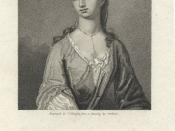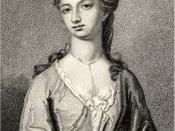The destruction of the grand style of the epic is just what Pope was after in his mock epic, 'The Rape of the Lock.' Pope had no such universal goal, or moral pronouncements to make as did Milton. His purpose was merely to expose the life of the nobility of his time. While Milton chose blank verse to express the immensity of the landscape of his epic, Pope chose to utilize the heroic couplet to trivialize this grandeur. Pope's quick wit bounces the reader along his detailed description of his parlor-room epic. His content is purposefully trivial, his scope purposefully thin, his style purposefully light-hearted, and therefore his choice of form purposefully geared toward the smooth, natural rhythm of the heroic couplet. The caesura, the end-stopped lines, and the perfect rhymes lend the exact amount of manners and gaiety to his work.
Writing for a society that values appearances and social frivolities, he uses these various modes of behavior to call attention to the behavior itself.
Pope compares and contrasts. He places significant life factors (i.e., survival, death, etc.) side by side with the trivial (although not to Belinda and her friends: love letters, accessories). Although Pope is definitely pointing to the 'lightness' of the social life of the privileged, he also recognizes their sincerity in attempting to be polite and well-mannered and pretend to
recognize where the true values lie.
Pope satirizes female vanity. He wrote the poem at the request of his friend, John Caryll, in an effort to make peace between real-life lovers. The incident of the lock of hair was factual; Pope's intention was to dilute with humor the ill feelings aroused by the affair. He was, in fact, putting a minor incident into perspective, and to this end, chose a mock-heroic form, composing the poem...


